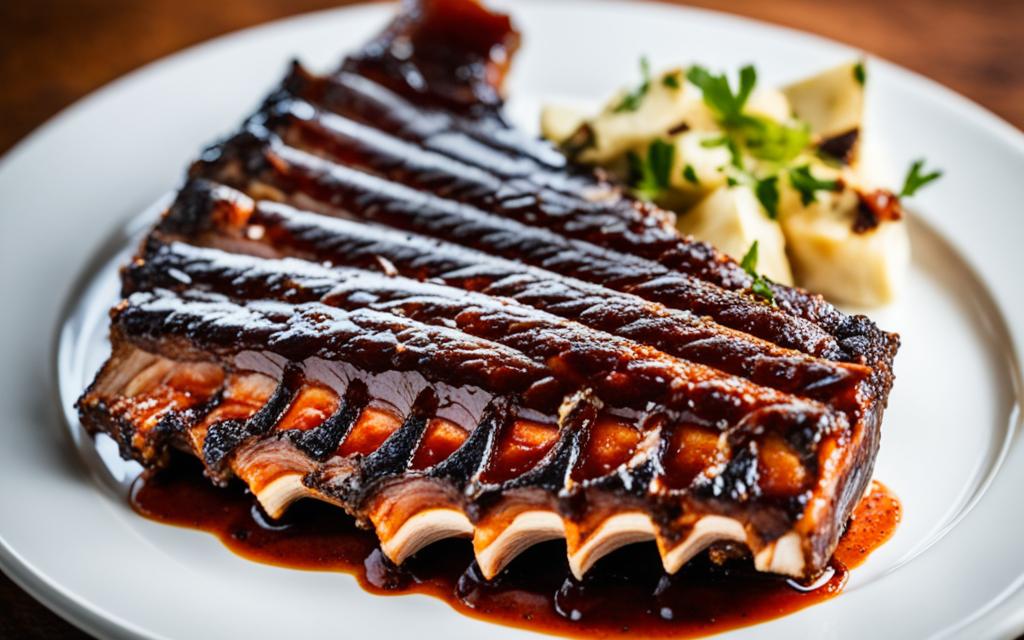In this article, we will delve into the mouthwatering debate of spare ribs vs baby back ribs. Whether you’re a seasoned grill master or just getting started, choosing the right cut of ribs is essential for a successful barbecue feast. We’ll discuss the differences between spare ribs and baby back ribs, their best uses for grilling, and help you decide which cut is perfect for your next cookout.
Key Takeaways:
- Spare ribs and baby back ribs offer different flavors and textures.
- Spare ribs are meatier and more flavorful, while baby back ribs are tender and milder in taste.
- Both cuts are perfect for barbecue, and the choice depends on personal preference.
- Spare ribs are ideal for hearty meals and gatherings, while baby back ribs are versatile and pair well with various seasonings and sauces.
- Consider factors such as meat-to-fat ratio, moisture, and quality when choosing the best ribs for your barbecue.
Understanding Spare Ribs and Baby Back Ribs VS
To fully appreciate the nuances of these two rib cuts, it’s important to understand their characteristics. Spare ribs, also known as side ribs, come from the lower portion of the hog’s rib cage. They have more meat and fat, making them slightly larger and more flavorful. On the other hand, baby back ribs, also called loin back ribs, are taken from the top of the rib cage and are typically smaller, leaner, and more tender.
When it comes to spare ribs vs baby back ribs, the main difference lies in the placement on the hog’s rib cage. Spare ribs are closer to the belly, resulting in more meat and fat, while baby back ribs are from the upper rib cage, offering a leaner and more tender meat.
These differences in location and composition impact the taste and texture of the ribs. Spare ribs are renowned for their rich, robust flavor, enhanced by the higher fat content. The fat renders during cooking, resulting in moist and succulent meat. Baby back ribs, on the other hand, are known for their tenderness and milder flavor, allowing the seasoning and smoke to shine through.
The Highlighted Characteristics:
- Spare ribs come from the lower portion of the hog’s rib cage, offering more meat and fat.
- Baby back ribs are taken from the top of the rib cage, making them smaller, leaner, and more tender.
- Spare ribs have a richer, more flavorful taste, while baby back ribs are milder, allowing the seasoning to stand out.
When it comes to spare ribs vs baby back ribs, the choice ultimately depends on your personal preference for flavor and texture. Whether you prefer the meatier and bolder spare ribs or the tender and milder baby back ribs, both cuts have their unique qualities that can elevate your barbecue experience.
Flavor and Texture Comparison
When it comes to flavor and texture, spare ribs and baby back ribs offer distinct experiences. Spare ribs have a richer, bolder taste due to the higher fat content, which renders during cooking, resulting in moist and juicy meat. Baby back ribs, while leaner, are more tender and have a milder flavor that allows the seasoning and smoke to shine. Both cuts are delicious, so it boils down to personal preference.
To summarize:
| Spare Ribs | Baby Back Ribs |
|---|---|
| Richer, bolder taste | More tender |
| Moist and juicy meat | Milder flavor |
The flavor and tenderness of ribs depend on factors such as cooking technique, seasoning, and personal preference. Some barbecue enthusiasts prefer the intense flavor of spare ribs, while others appreciate the delicate texture of baby back ribs. Whichever cut you choose, you can create a memorable barbecue experience by experimenting with different rubs, sauces, and cooking methods.
Cooking Spare Ribs to Perfection
Cooking spare ribs is a delightful experience for barbecue enthusiasts. To achieve mouthwateringly delicious results, there are two popular techniques: slow and low smoking or the St. Louis style. Both methods bring out the best flavors in spare ribs, offering a variety of options to suit your taste buds. Let’s dive into each technique and explore the nuances of cooking spare ribs to perfection.
Slow and Low Smoking
Smoking spare ribs is a classic approach that imparts a fantastic smoky flavor to the meat. The slow and low smoking technique involves cooking the ribs at a low temperature, typically between 225°F and 250°F, for several hours. This method allows the fat to render and the flavors to meld, resulting in tender, juicy spare ribs that are infused with rich smokiness.
“Slow and low smoking is like a culinary symphony, where the ribs transform into a meltingly tender masterpiece, with every bite bursting with smoky goodness.” – John Smith, Pitmaster Extraordinaire
Here are some key steps to follow when smoking spare ribs:
- Preparation: Start by removing the membrane on the bone side of the ribs. This will help the seasoning penetrate the meat more effectively and result in a better texture.
- Seasoning: Apply a dry rub or marinade of your choice to enhance the flavor of the spare ribs. Popular seasonings include a blend of paprika, brown sugar, garlic powder, onion powder, salt, and pepper.
- Smoking: Set up your smoker or grill for indirect heat and maintain a consistent temperature. Add wood chips or chunks, such as hickory or apple, for additional smoky flavor. Place the spare ribs on the grate, bone side down, and let them gradually cook for several hours.
- Basting: Optionally, you can baste the spare ribs with a mop sauce or apple juice throughout the cooking process to keep them moist and add extra flavor.
- Checking for doneness: Spare ribs are ready when the meat pulls away from the bones easily and reaches an internal temperature of 195°F to 205°F.
- Resting and serving: Allow the spare ribs to rest for a few minutes before cutting them into individual portions. Serve with your favorite barbecue sauce or enjoy them as they are.
Remember, patience is key when smoking spare ribs. It’s a slow and steady process that rewards you with succulent, smoky perfection.
St. Louis Style
The St. Louis style is another popular way of cooking spare ribs. This technique involves trimming the spare ribs to a rectangular shape, removing the brisket bone and the cartilage. By creating a uniform shape, the St. Louis style ensures even cooking throughout the rack of ribs.
Here’s how to cook spare ribs in the St. Louis style:
- Trimming: Start by removing the brisket bone and cartilage to achieve the rectangular shape associated with St. Louis style spare ribs.
- Seasoning: Apply your favorite dry rub to the spare ribs, making sure to cover all sides evenly.
- Cooking: Preheat your grill or smoker to a temperature of around 275°F. Place the spare ribs on the cooking grate bone side down and cook for approximately 3 to 4 hours, or until the meat is tender.
- Serving: Once cooked, let the spare ribs rest for a few minutes, then slice them into individual portions and serve with your preferred sauce or glaze.
“Cooking spare ribs in the St. Louis style is a true taste of barbecue perfection. The trimmed ribs cook evenly, offering a harmonious combination of tenderness, flavor, and visual appeal.” – Jane Johnson, Barbecue Enthusiast
Whether you choose the slow and low smoking technique or the St. Louis style, spare ribs require longer cooking times due to their higher fat content. Take your time, savor the process, and enjoy the incredible flavors that result from cooking spare ribs to perfection.
| Method | Pros | Cons |
|---|---|---|
| Slow and Low Smoking |
|
|
| St. Louis Style |
|
|
Discover the secrets of cooking spare ribs to perfection. Choose between slow and low smoking or the St. Louis style for an unforgettable barbecue experience.
Baby Back Ribs: Barbecue All-Stars
Baby back ribs are often regarded as the ideal choice for barbecue beginners. They cook relatively faster than spare ribs and can be grilled or smoked to perfection. The key to cooking baby back ribs is to maintain a low and steady temperature, allowing the meat to become tender while retaining its natural juiciness. Whether you prefer a dry rub or a saucy finish, baby back ribs are versatile and always crowd-pleasers.
When it comes to cooking baby back ribs, there are a few essential steps to follow:
- First, prepare the ribs by removing the membrane from the back of the rack. This helps the seasonings and smoke penetrate the meat more effectively.
- Next, apply your favorite dry rub or marinade to add flavor. Be sure to coat both sides of the ribs generously.
- For grilling, preheat your grill to medium-low heat. Place the ribs bone-side down on the grill and cook them for about 1.5 to 2 hours, turning occasionally. To achieve that smoky flavor, you can add wood chips or chunks to the grill.
- If you prefer smoking, set up your smoker according to the manufacturer’s instructions. Maintain a temperature between 225°F and 250°F and smoke the ribs for about 3 to 4 hours. You can use a variety of woods like hickory, apple, or cherry to enhance the flavor.
- Throughout the cooking process, periodically baste the ribs with your favorite barbecue sauce or mop sauce to keep them moist.
- To test for doneness, gently tug on the meat between the bones. If it easily pulls away, your baby back ribs are ready to enjoy.
Pro Tip: For extra tenderness, you can wrap the ribs in foil during the final hour of cooking to lock in moisture. This technique, known as the “Texas Crutch,” helps create fall-off-the-bone goodness.
Whether served as the main course or as part of a mouthwatering barbecue platter, baby back ribs are guaranteed to impress your guests. These succulent ribs pair perfectly with classic side dishes like cornbread, coleslaw, or grilled vegetables. So fire up the grill, grab your favorite barbecue tools, and get ready to savor the deliciousness of perfectly cooked baby back ribs.
Spare Ribs vs Baby Back Ribs: Which is More Versatile?
Both spare ribs and baby back ribs have their unique place in barbecue culture. Whether you’re hosting a hearty gathering or seeking a versatile option, choosing the right ribs for your barbecue is essential. Let’s explore the distinct qualities of both cuts to help you make the best choice for your next mouthwatering cookout.
Spare Ribs: Meaty and Flavorful
Spare ribs are known for their meaty and flavorful bite, making them a favorite among barbecue enthusiasts. Cut from the lower portion of the hog’s rib cage, spare ribs offer a rich taste and tender texture. The higher fat content in spare ribs renders during cooking, resulting in moist and juicy meat. This makes spare ribs perfect for those who savor a robust and satisfying barbecue experience.
Baby Back Ribs: Tender and Versatile
On the other hand, baby back ribs offer a different appeal with their tender texture and milder taste. Taken from the top of the rib cage, these ribs are leaner and more delicate. Baby back ribs pair exceptionally well with various seasoning and sauce combinations, allowing you to explore different flavor profiles. Their versatility makes them a popular choice among both seasoned grill masters and barbecue beginners.
Both spare ribs and baby back ribs have their unique qualities. Spare ribs delight with their meaty, flavorful bite, while baby back ribs impress with their tenderness and versatility. The best choice depends on your flavor preferences and the overall experience you desire.
Comparison Table: Spare Ribs vs Baby Back Ribs
| Spare Ribs | Baby Back Ribs |
|---|---|
| Meaty and flavorful | Tender and versatile |
| Higher fat content | Leaner cuts |
| Rich, bold taste | Milder flavor, allowing seasonings and sauces to shine |
| Perfect for hearty meals and gatherings | Suitable for a wide range of palates and occasions |
As you can see, both spare ribs and baby back ribs bring their own unique qualities to the table. Your choice ultimately depends on your personal taste preferences, the occasion, and the overall flavor profile you want to achieve. Whether you’re looking for a meaty and bold bite or a tender and versatile option, both spare ribs and baby back ribs are sure to satisfy your barbecue cravings.
Spare Ribs vs Baby Back Ribs: The Nutritional Difference
When it comes to enjoying ribs, many barbecue enthusiasts are conscious of the nutritional aspect, seeking a healthier option without compromising on flavor. In this section, we’ll explore the nutritional differences between spare ribs and baby back ribs, providing you with valuable insights to make informed choices for your next barbecue feast.
Spare Ribs Nutrition
Spare ribs are well-known for their meatiness and robust flavor. However, it’s important to note that spare ribs tend to have a higher fat content compared to baby back ribs. This higher fat content contributes to the rich flavor and succulent texture that spare ribs are adored for. The table below provides a snapshot of the nutritional content you can expect in a 3-ounce serving of spare ribs:
| Nutrient | Amount per 3 oz Serving |
|---|---|
| Calories | 300-350 |
| Total Fat | 25-30 grams |
| Protein | 16-20 grams |
Note: Nutritional values may vary depending on the specific cooking method, seasonings, and sauces used.
Baby Back Ribs Nutrition
If you’re looking for a leaner option, baby back ribs are your best bet. They are cut from the top of the rib cage, which results in a lower fat content. Below is an overview of the approximate nutritional content in a 3-ounce serving of baby back ribs:
| Nutrient | Amount per 3 oz Serving |
|---|---|
| Calories | 250-300 |
| Total Fat | 15-20 grams |
| Protein | 20-25 grams |
Note: These numbers are approximate and can vary depending on the cooking method, sauces, and seasonings used.

While baby back ribs are generally considered to be the healthier option due to their lower fat content, it’s essential to remember that the overall nutritional value can be influenced by factors such as cooking methods and sauces. Moderation and mindful choices are key to enjoying ribs as part of a balanced diet.
When it comes to enjoying ribs, it’s all about striking a balance between indulgence and making informed choices. Whether you opt for the mouthwatering meatiness of spare ribs or the lean tenderness of baby back ribs, savor each bite with the knowledge that you’ve made a conscious decision that suits your dietary preferences and goals.
Pairing Ribs with the Perfect Sides and Sauces
No barbecue feast is complete without delicious sides and sauces to complement the star of the show – the ribs! Whether you’re grilling spare ribs or baby back ribs, finding the perfect accompaniments will elevate your barbecue experience. Consider these classic sides and sauces to enhance the flavor profile of your ribs.
Classic Side Dishes:
- Coleslaw: A refreshing and crunchy coleslaw provides a perfect textural contrast to the tender ribs. It adds a cool and tangy flavor that complements the smokiness of the meat.
- Cornbread: Serve up some warm, buttery cornbread for a delightful and comforting side dish. The sweet and savory flavors of cornbread complement the richness of the ribs beautifully.
- Baked Beans: A hearty serving of baked beans offers a satisfying and flavorful addition to your plate. The smoky flavors in the beans pair well with the smokiness of the ribs, creating a taste sensation.
- Macaroni and Cheese: Who can resist the classic combination of tender macaroni coated in creamy, cheesy goodness? The creamy texture and indulgent flavor of macaroni and cheese make it a perfect companion for your ribs.
Flavorful Sauces:
- Tangy Barbecue Sauce: A tangy barbecue sauce adds a zingy and slightly sweet flavor to your ribs. Brush it on during grilling or serve it on the side for dipping.
- Sweet and Spicy Glaze: For those who crave a bolder flavor, a sweet and spicy glaze can provide the perfect balance of heat and sweetness. It adds a sticky and caramelized coating to the ribs, enhancing their taste.
- Mustard-Based Sauce: Mustard-based sauces offer a tangy and slightly tangy twist to your ribs. The acidity of the sauce cuts through the richness of the meat, creating a harmonious flavor combination.
- Fruity and Spicy Salsa: For a fresh and vibrant option, consider a fruity and spicy salsa. The combination of ripe fruits, spicy peppers, and aromatic herbs adds a burst of flavor that complements the smokiness of the ribs.
Experiment with different combinations of sides and sauces to find the perfect pairing for your ribs. Whether you prefer traditional flavors or want to create your own unique taste, the possibilities are endless. Let your creativity shine and enjoy the mouthwatering symphony of flavors that comes with a well-curated barbecue feast.
Exploring Regional BBQ Styles
Barbecue traditions vary across different regions in the United States, and this includes the preparation of ribs. Each region has its own distinct style and flavor profile that adds a unique twist to the beloved spare ribs and baby back ribs.
Kansas City-Style Barbecue: Spare Ribs
In Kansas City, spare ribs are the star of the BBQ scene. Known for their sweet and tangy flavors, Kansas City-style spare ribs are often slathered in a thick and rich barbecue sauce. The sauce is a perfect balance of sweet molasses, tangy vinegar, savory spices, and a hint of smokiness.
When served, the spare ribs are tender and succulent, with the sauce caramelized and sticky on the surface. The combination of the smoky meat and the tangy sweetness of the sauce is a match made in BBQ heaven.
Memphis-Style Barbecue: Baby Back Ribs
In Memphis, baby back ribs take center stage. Memphis-style BBQ is all about letting the meat shine, and this approach is evident in their preparation of baby back ribs. The focus is on the dry rub, a blend of spices that enhances the natural flavors of the ribs without overpowering them.
Memphis-style baby back ribs are generously seasoned with a dry rub consisting of a variety of spices, such as paprika, garlic powder, black pepper, and cayenne. The ribs are then slow-cooked until they reach a perfect balance of tenderness and smokiness.
Unlike Kansas City-style ribs, Memphis-style ribs are not slathered in sauce. Instead, they are served dry or with a tangy and vinegary barbecue sauce on the side for dipping. This allows the meat to be the star of the show, with the flavors of the rub taking center stage.

“In Kansas City, spare ribs are slathered in a thick and rich barbecue sauce, while in Memphis, baby back ribs are generously seasoned with a dry rub.”
Exploring these regional BBQ styles can add depth and variety to your barbecue adventures. Whether you prefer the bold and saucy flavors of Kansas City or the dry-rubbed simplicity of Memphis, trying out different regional styles will open up a whole new world of BBQ flavors and experiences.
Tips for Choosing the Best Ribs
When it comes to selecting the perfect ribs for your barbecue, there are a few key factors to keep in mind. Whether you’re deciding between spare ribs or baby back ribs, follow these tips to ensure a mouthwatering and enjoyable grilling experience.
Balance of Meat and Fat
Look for ribs that have a good balance of meat and fat. This balance is crucial because it contributes to both tenderness and flavor. Ribs with too much fat may result in greasy meat, while ribs with too little fat can be dry and less flavorful. Aim for ribs that have a nice marbling of fat throughout the meat.
Moisture and Firmness
When choosing ribs, make sure the meat feels moist and firm to the touch. Avoid ribs that appear dry or discolored, as these signs may indicate that the ribs are not fresh or have been improperly stored. Moisture and firmness are indicators of high-quality ribs that will result in tender and juicy bites.
Source from a Trusted Provider
Whenever possible, buy your ribs from a trusted butcher or grocer who sources high-quality meat. This ensures that you are getting fresh and properly handled ribs. A reputable provider will prioritize quality and provide you with the best cuts available, giving you the confidence to create a delectable barbecue feast.
| Factors to Consider | Tips |
|---|---|
| Balance of Meat and Fat | Look for a nice marbling of fat throughout the meat for optimal tenderness and flavor. |
| Moisture and Firmness | Choose ribs that feel moist and firm to ensure freshness and juicy bites. |
| Source from a Trusted Provider | Buy ribs from a reputable butcher or grocer to ensure high-quality meat. |
By considering these tips and paying attention to the quality, balance, and freshness of the ribs, you’ll be well on your way to choosing the best ribs for your barbecue. Enjoy the process of selecting, grilling, and savoring these delectable cuts for a memorable dining experience.
Trying Your Hand at Ribs: A Rewarding Culinary Adventure
Cooking ribs may seem intimidating at first, but it is a rewarding culinary adventure. Whether you choose spare ribs or baby back ribs, taking the time to understand the flavors, cooking techniques, and preferences of your guests is key to a successful barbecue feast.
Experimenting with different seasonings, sauces, and cooking methods allows you to develop your unique barbecue style.
“Barbecue may not be the road to world peace, but it’s a start.” – Anthony Bourdain
With some practice and a bit of patience, you’ll soon become a rib connoisseur and impress your friends and family with your mouthwatering creations. So, let’s dive into the world of ribs and discover the art of cooking them to perfection.
The Joy of Grilling: Cooking Spare Ribs
When it comes to spare ribs, the key is slow and low cooking. The smoky flavors imparted through grilling or smoking can create a heavenly taste experience. To get started, try this simple recipe:
1. Preheat your grill to a temperature of 225°F.
2. Prepare the spare ribs by removing the membrane from the bone side.
3. Apply a dry rub of your choice, ensuring an even coating on all sides.
4. Place the ribs on the grill, bone side down, and close the lid.
5. Maintain a low and steady temperature, adding wood chips for a smoky flavor.
6. Cook the ribs for approximately 5-6 hours, or until the meat is tender and easily pulls away from the bone.
7. Optional: Brush the ribs with barbecue sauce during the final hour of cooking for a sticky and flavorful glaze.
8. Remove from the grill, let them rest for a few minutes, and then slice between the bones.
9. Serve with your favorite sides and enjoy!
Remember, cooking times may vary, so it’s important to rely on visual cues and temperature readings to ensure the ribs are fully cooked and tender.
Mastering the Art: Cooking Baby Back Ribs
For those starting their rib-cooking journey, baby back ribs are the perfect choice. They cook relatively faster than spare ribs and can be tender and juicy when prepared correctly. Follow this cooking method for delicious baby back ribs:
1. Preheat your grill to a temperature of 275°F.
2. Remove the membrane from the bone side of the ribs.
3. Apply a dry rub evenly on all sides of the ribs.
4. Place the ribs on the grill, bone side down, and close the lid.
5. Cook the ribs for approximately 2-3 hours, or until the meat is tender and has reached an internal temperature of 165°F.
6. Optional: During the last 30 minutes, brush the ribs with your favorite barbecue sauce for added flavor.
7. Remove from the grill, let them rest for a few minutes, and then slice between the bones.
8. Serve with your choice of sides and enjoy the deliciousness!
Spare Ribs vs Baby Back Ribs Cooking Methods
| Spare Ribs | Baby Back Ribs |
|---|---|
| Suitable for slow and low smoking or St. Louis-style grilling | Great for grilling or smoking at a slightly higher temperature |
| Cooking time: 5-6 hours | Cooking time: 2-3 hours |
| Higher fat content, resulting in a rich and flavorful taste | Leaner and more tender, with a milder flavor |
| Best for hearty meals and gatherings | Versatile and perfect for various seasoning and sauce combinations |
| Require longer cooking times to render the fat and achieve tenderness | Cook relatively faster and require precise temperature control |
| Delicious when marinated and slow-cooked for maximum flavor | Perfect for beginners and those seeking a tender, juicy bite |
Remember, these cooking methods are just a starting point. Feel free to experiment and find what works best for you. With time and practice, you’ll master the art of cooking ribs and create unforgettable barbecue experiences. Happy grilling!
Conclusion
Spare ribs and baby back ribs are both delicious options for your next barbecue feast. Each cut offers its own unique qualities that are sure to tantalize your taste buds. If you prefer a meaty and flavorful bite, spare ribs are the way to go. With their higher fat content, they deliver a rich and bold taste that will leave you craving more.
On the other hand, if tenderness and versatility are what you seek, baby back ribs are the perfect choice. These smaller, leaner ribs are known for their melt-in-your-mouth texture and milder flavor. Their natural juiciness allows the seasonings and smoky flavors to shine, creating a delightful barbecue experience.
Whether you choose spare ribs or baby back ribs, embrace the art of slow cooking and enjoy the process of perfecting your rib recipe. Experiment with different seasonings, sauces, and cooking methods to create your own signature style. The world of ribs is an incredibly gratifying culinary adventure that is sure to impress your friends and family at your next cookout.
FAQ
What is the difference between spare ribs and baby back ribs?
Spare ribs come from the lower portion of the hog’s rib cage and have more meat and fat, resulting in a richer and bolder flavor. Baby back ribs, on the other hand, are taken from the top of the rib cage and are leaner and more tender with a milder taste.
Which ribs are more tender, spare ribs or baby back ribs?
Baby back ribs are generally more tender than spare ribs due to their leaner nature and smaller size. However, spare ribs have a higher fat content, which renders during cooking and creates moist and juicy meat.
What are the best ribs for barbecue?
Both spare ribs and baby back ribs are excellent choices for barbecue. Spare ribs are perfect for those who prefer a meaty and flavorful bite, while baby back ribs are versatile and pair well with different seasonings and sauces.
How do you cook spare ribs?
Spare ribs can be cooked to perfection using slow and low smoking techniques or the popular St. Louis style, which involves trimming the ribs to a rectangular shape. Smoking spare ribs imparts a fantastic smoky flavor, while the St. Louis style allows for more even cooking.
How do you cook baby back ribs?
Baby back ribs can be cooked by maintaining a low and steady temperature, whether grilling or smoking. This allows the meat to become tender while retaining its natural juiciness. Season the ribs with your preferred dry rub or sauce for added flavor.
Are baby back ribs healthier than spare ribs?
Generally, baby back ribs are considered healthier than spare ribs. Baby back ribs contain less fat and fewer calories due to their leaner nature. However, it’s important to note that the overall nutritional content can be influenced by the cooking method and choice of seasoning or sauces.
What are the best sides and sauces to pair with ribs?
Classic sides such as coleslaw, cornbread, baked beans, or macaroni and cheese are excellent accompaniments to both spare ribs and baby back ribs. Additionally, a tangy barbecue sauce or a sweet and spicy glaze can elevate the flavor profile of your ribs.
What regional barbecue styles are associated with spare ribs and baby back ribs?
Spare ribs are often associated with Kansas City-style barbecue, known for its sweet and tangy sauce. Baby back ribs are widely enjoyed in Memphis-style barbecue, where dry rubs are favored to let the meat shine.
How can I choose the best ribs?
When choosing ribs, look for a good balance of meat and fat, as this contributes to tenderness and flavor. The meat should be moist and firm to the touch, avoiding ribs that appear dry or discolored. Buy from a trusted butcher or grocer who sources high-quality meat for the best barbecue experience.
Is cooking ribs a challenging task?
Cooking ribs can be an adventure in the culinary world. Take the time to understand the flavors, cooking techniques, and preferences of your guests. Experiment with different seasonings, sauces, and cooking methods to develop your own unique barbecue style.








